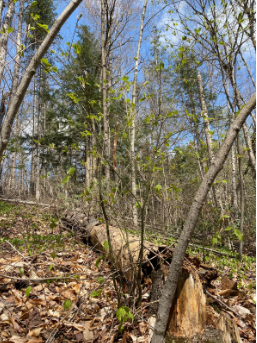May Kids Corner from the Gale River Cooperative Preschool
To leaf or not to leaf
In northern New England, the month of May marks the switch between spring and summer growth for plants. At the beginning of the month, the trees are mostly barren, still sporting their buds. By the end of the month, the forest is awash in green and the canopy is full. How do the trees know when to leaf out? Why do they open their leaves at different times?
During the previous summer, the deciduous trees were preparing their buds for the following year. All winter long, the trees are dormant, storing their energy for the growing season. As the amount of daylight gets longer in late spring and the weather warms up, the trees begin to open their buds and the leaves fully emerge. The job of the leaves is to absorb sunlight and transform it into food through a process called photosynthesis. As they photosynthesize, they are creating oxygen which we breathe! The larger the leaf, the more food it can produce. Some trees make a lot of tiny leaves, in case some are lost in bad weather or through disease. Other trees put all their energy into making a few large leaves, betting that they will survive the growing season and make a lot of food.
In the northeast, our spring weather can be unpredictable. It can suddenly get quite cold again after a long warm stretch. Our trees are adapted to this and some of them wait longer to leaf out. They want to protect their leaves from freezing which would damage them. Birches and willows will leaf out early to try and get the longest growing season they can, but they risk their leaves freezing. Oaks and elms will wait longer to protect their leaves. If you’re not sure why your tree hasn’t leafed out yet, check the buds. If they’re green inside, they’re healthy and are just taking their time.
Want tips on how to explore leaves this May? Here are some ideas before you head outside!
Leaves come in all different shapes and sizes. Some are heart shaped, some oval, some pointy, and some smooth. Just like flowers you can press leaves to preserve them. Try to collect a variety of leaves (only take a small number from one tree!) and press them between wax paper in a heavy book for a few weeks. You could use them for art or create your own book comparing the differences and similarities.
Leaves have unique and interesting textures. One way to copy a leaf without picking it is to take a rubbing. All you need is a hard surface, a piece of paper and a crayon. Place your leaf between the hard surface and the paper and lightly rub the crayon on the paper. The details of the leaf should appear! You can compare textures and identify which tree’s leaves are smooth, rough, veiny, etc.
Interested in leaf activities and crafts? We’ve got you covered!
Leaves are full of chlorophyll, the chemical that allows them to photosynthesis and makes them green. A fun craft is to make hammered leaf prints! You can do this onto sturdy paper or even cloth. Collect some leaves and lay them against the material you want the color transferred to. Place a paper towel or wax paper on top and begin to hammer with a mallet. Make sure you cover the whole surface area. Once you’re done, peel away your top layer and the print will be revealed below! If there is plant residue stuck to it, wait for it to dry and you can brush it off.
Leaf painting is another fun way to create prints. As spring leaves are more malleable than dry fall leaves, this is a great time to paint them and print with them. Collect your leaves, paint on them, then press the painted side onto paper. You should have a colorful replica of the leaf’s shape and texture.
Thanks to our partner, the Gale River Cooperative Preschool in Bethlehem, for helping our area parents get kiddos outside for fun no matter the time of year.
We can't wait to share the family fun we're planning with you. Keep an eye out in the coming months for announcements.





